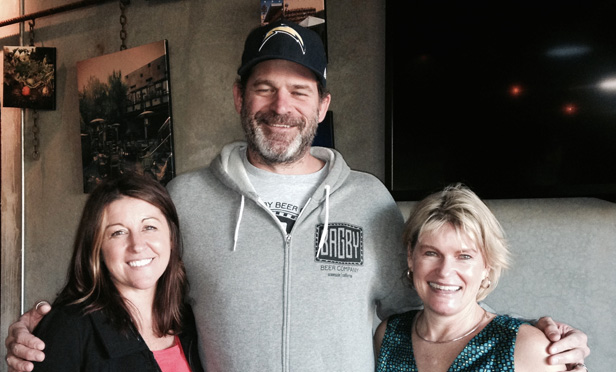 Medley (right, with Dande and Jeff Bagby of Bagby Beer Company in Oceanside): “We’re seeing a migration from the big production breweries to infill, going to where the customers are.”
Medley (right, with Dande and Jeff Bagby of Bagby Beer Company in Oceanside): “We’re seeing a migration from the big production breweries to infill, going to where the customers are.”
NEW YORK CITY—No matter who we talk with—and GlobeSt.com just talked with three Lee & Associates specialists in craft-brewery brokerage from various MSAs—the trend seems to be the same: the local taste for craft beer is sated first at the CBD level and rapidly expands throughout the local MSA.
And, however it spreads, it is undeniable that this once-cottage industry has grown into big business. In fact, according to the Brewers Association, a group dedicated to promoting craft beers and headquartered (not surprisingly) in Boulder, CO, some 24.5 million barrels were produced in 2015, representing total retail sales of $22.3 billion. That’s a 13% increase over the prior year.
We’ve all seen, or maybe spent too much time in, the growing crop of tasting rooms springing up around the country, with windows into cool-looking production facilities. But while the overall effect can be chalked up to customer experience, from a broker’s standpoint, these are treated as part industrial and part retail facility, sometimes with rents at different rates.
“We’re seeing a migration from the big production breweries to infill, going to where the customers are, toward the core of the city,” says Monique Medley, a senior associate in Lee’s Carlsbad, CA office. And those that have that dual setup, she reports, “can make about a fifth more per beer in profits.”
Manufacture and retail might “be in the same footprint,” adds Marley Welsh, a senior associate in the Columbia, MD office, “but there are definitely different rents, with the actual rate dependent as well on what the landlord contributes.” Both Medley and Welsh agree that the difference between the industrial and retail portions hovers around $2 a foot.
 Welsh: Manufacture and retail might often “be in the same footprint, “but there’s definitely different rents.”
Welsh: Manufacture and retail might often “be in the same footprint, “but there’s definitely different rents.”
Scot Courtney, president of the Indianapolis Lee office, notes that not all brewers opt for two operations in one footprint. He cites Sun King Brewing in Indiana, which opted for separate facilities. Another increasingly common aspect of retail brewing is the addition of food service in many of the tasting rooms.
Who’s driving the growth in craft breweries? No matter the geographic market, the entrepreneurs defy definition, ranging from small entrepreneurs to larger concerns such as Sun King. “There is no specific age or affiliation,” says Courtney. “It’s all over the map.”
That diversity in clientele requires brokers in the know, in both real estate and the craft of craft beer. “There are certain state restrictions about brewery locations in Tax Increment Financing districts,” Courtney continues, “even though, ironically, the breweries themselves are now being viewed as economic development vehicles.”
 Courtney: “There are state restrictions about locations in Tax Increment Financing districts, even though, ironically, the breweries themselves are now being viewed as economic development vehicles.”
Courtney: “There are state restrictions about locations in Tax Increment Financing districts, even though, ironically, the breweries themselves are now being viewed as economic development vehicles.”
And, of course, there are the basics of real estate, which newcomers especially are ill-equipped to handle. “They have to be educated in such basics as parking requirement and other zoning issues,” says Welsh.
“We’re seeing restrictions mainly in higher-end coastal communities that don’t like large beach crowds going in and out of breweries,” says Medley, adding another nuance to the guidance providers must give. “Many brewers are not yet well versed on commercial real estate.”
But in just one town within her bailiwick, Vista, she reports that the current count of 12 breweries is expected to rise to 17 by year end, and in San Diego County, there are now 126 and growing. Courtney and Welsh report similar gains in their markets.
As Medley concludes, with this rapid level of growth, it serves client and broker alike for the service provider “to be a more creative broker. For instance, aside from merely brokering a deal, I’m always thinking of those in the industry I can connect to each other, such as an equipment broker with a new brewery or a client with the right craft brew attorney.”

















 Copyright © 2024 ALM Global, LLC. All Rights Reserved.
Copyright © 2024 ALM Global, LLC. All Rights Reserved.